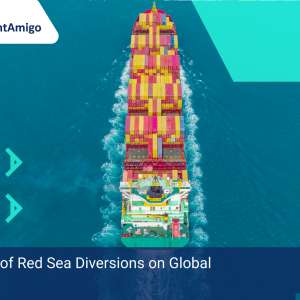The Ripple Effect of Red Sea Disruptions on Ocean Freight Rates:
What You Need to Know
Latest update on 23 May, 2024 by Aurora Park– Marketing Analyst at FreightAmigo
In an increasingly interconnected world, the smooth operation of global logistics networks is critical for the health of international trade. Disruptions in key maritime corridors, such as the Red Sea, can have profound ripple effects on ocean freight rates, impacting businesses and economies worldwide. In recent months, disruptions in the Red Sea have caused a surge in global ocean freight rates. According to data agency Freightos, container rates from Asia have risen by approximately $1,000/FEU (40-foot containers) since the end of April. Currently, rates stand at around $4,000/FEU for the West Coast and North Europe lanes, $5,000/FEU for the Mediterranean lane, and $5,400/FEU for the East Coast lane.
The impact of these disruptions is reflected in China’s export container freight index, which saw a 3.7% increase in the previous period, and the Shanghai Export Container Freight Index, which rose by 18.8% during the same period, according to data released by the Shanghai Shipping Exchange on May 10.This article will explore the impact of Red Sea disruptions on global ocean freight rates, delving into why these incidents have led to surging freight costs. We will also examine the broader implications of such disruptions on the logistics industry and present strategies for navigating this volatility.
Want To Compare The Best Express, Air Freight, Sea Freight, Rail Freight & Trucking Rates So As To Have Better Control On Cost?
The Impact of Red Sea Disruptions on Global Ocean Freight
The recent crisis in the Red Sea, triggered by attacks on container ships, has significantly impacted global ocean freight. The disruption has led to delays, increased costs, and upended supply chains, affecting major shipping canals and global trade routes. The Suez Canal, a crucial link between Europe and Asia, has seen a dramatic drop in maritime traffic, with an 80% decrease compared to pre-crisis levels. This has made the canal a less preferred option, leading to higher shipping rates and prolonged transit times.
Key Impacts on Ocean Freight Rates
- Surge in Freight Rates:Extended detours around the Cape of Good Hope have significantly increased ocean freight rates, with costs reaching up to $10,000 per 40-foot container.
- Increased Operational Costs:Diverting vessels around the Cape of Good Hope has introduced additional costs of up to $1,000 per TEU, coupled with a 30% rise in fuel consumption.
- War Risk Premiums:The premiums have surged to nearly 1% of a ship’s value, reflecting the heightened risk in the region.
- Suez Canal Transit Fees:The Suez Canal Authority has announced a 5-15% hike in transit fees, adding to the overall costs.
Why Are Ocean Freight Rates Surging?
The surge in ocean freight rates, particularly observed since the disruptions in the Red Sea, can be attributed to a confluence of factors impacting the global shipping industry. These factors have not only influenced the cost of shipping but have also affected the operational dynamics of maritime logistics. Here, we delve into the primary reasons behind the persistent high rates and the challenges faced by the industry.
Contributing Factors to High Ocean Freight Rates
- Extended Rerouting and Delays: The necessity to reroute vessels via the Cape of Good Hope due to the Red Sea crisis has significantly impacted on-time performance and schedule reliability. This rerouting has led to extended transit times, exacerbating the already strained supply chains and complicating logistics planning for shippers.
- Increased Demand During Peak Seasons: The period following the Chinese Labor Holiday witnessed robust bookings, indicating a strong demand. This surge, especially in comparison to the low demand in Q1 2023, has put additional pressure on shipping rates. The anticipation of General Rate Increases (GRI) has further fueled this demand, as shippers rush to move cargo before rates climb higher.
- Equipment Shortages and Port Congestion: Major carriers report ongoing equipment shortages, which are expected to continue affecting the market. The proactive pickup of containers as soon as possible is advised to mitigate delays. Additionally, port congestions have exacerbated the situation, leading to further hikes in shipping rates.
- Market Adjustments Post-Red Sea Diversions: The adjustments in trade lanes following the Red Sea diversions have introduced structural challenges within the shipping industry. These adjustments necessitate recalibration of expectations and strategies by all market participants, bracing for continued delays, longer lead times, and higher costs.
Navigating Uncertainty: Developing Strategies in an Unpredictable Market
In response to the ongoing Red Sea crisis, which has significantly impacted ocean freight rates and global trade, it is imperative for businesses and policymakers to adopt a multifaceted approach to navigate the uncertainty. The crisis, marked by attacks on commercial vessels and a subsequent downturn in maritime activity, necessitates a strategic reassessment of logistics and supply chain management.
Strategic Reassessment and Diversification
- Continuous Monitoring and Assessment: It is crucial for stakeholders to remain vigilant, continuously assessing the evolving impacts on global trade and logistics. This involves keeping abreast of the latest developments in the Red Sea crisis and adjusting strategies accordingly.
- Fiscal and Monetary Policy Frameworks: Governments should maintain robust policy frameworks to mitigate economic vulnerabilities. Depending on the severity of the impacts, countermeasures such as countercyclical interventions may be considered to cushion economies against shocks.
- Exploring Growth Opportunities: The crisis presents opportunities for growth through re-shoring, near-shoring, and friend-shoring strategies. Countries geographically close to major economic blocs can leverage these strategies to attract foreign direct investment, boosting local economies.
Conclusion
Throughout this article, we have explored the intricate ballet of factors influencing ocean freight rates, underlined by the disruptions in the Red Sea and their far-reaching implications on global trade and logistics. It’s clear that understanding these dynamics is crucial, not only for navigating the immediate challenges they present but also for anticipating the broader economic and environmental impacts. By examining the surge in freight costs, recognizing the reasons behind the high rates, and outlining strategies for navigating market uncertainty, we provide stakeholders with a comprehensive overview essential for mitigating the adverse effects of such disruptions.
For those seeking to navigate these turbulent waters, leveraging platforms like FreightAmigo can offer critical insights and solutions tailored to meet the challenges of an unpredictable market. Our exploration concludes on the note that the ripple effects of maritime disruptions demand a concerted effort from all sectors of the global economy, a task that requires cooperation, innovation, and a steadfast commitment to overcoming the hurdles of tomorrow.
If You Wish To Learn More About Ocean Freight Rates, Please Go To The FreightAmigo Page For Inquiries
Read more:
Logistics News | Red Sea Crisis Disrupts Supply Chains | FreightAmigo
Logistics News | Continued Uncertainty in Red Sea Route | FreightAmigo
If you have any inquiries on logistics / supply chain, feel free to contact FreightAmigo now:
Chat with us online | Hotline: +852 28121686 | WhatsApp: +852 27467829









































